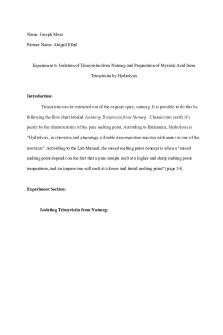Lab 5 Report PDF

| Title | Lab 5 Report |
|---|---|
| Author | Manuela Dorado |
| Course | Organic Chemistry II |
| Institution | Bellevue College |
| Pages | 8 |
| File Size | 279.1 KB |
| File Type | |
| Total Downloads | 88 |
| Total Views | 155 |
Summary
Lab 5 report...
Description
Manuela Dorado Novoa
Lab 5 Report – Week 7
THE CRAYFISH SLOW FLEXOR MUSCLE AND THE THIRD NERVE Synaptic transmission is the biological process by which a neuron communicates with a target cell across a synapse. Under normal conditions, at the vertebrate neuromuscular junction (NMJ), a single motor axon makes synaptic contact with a single muscle cell. Synaptic transmission occurs at this single location. At the invertebrate NMJ, muscle cells of the superficial flexor muscles (SFM) are innervated at multiple sites along their length. Invertebrate neuromuscular junctions are structurally closer to central synapses than to many vertebrate neuromuscular junctions, and have often been used as a convenient model for central neurotransmission. The NMJs in crustaceans offer many advantages for addressing mechanism of action in modulation of synaptic efficacy at NMJs. The crayfish abdominal nerve cord has been widely investigated because of its relative simplicity. The cord consists of six ganglia joined by connectives. From each ganglion, three bilateral pairs of nerves ("roots") innervate the muscles and sensory receptors in that abdominal segment. Each of the three roots has a different destination in its segment of the abdomen. The motoneurons are tonically active, generating spontaneous spikes. This tonic motor activity produces a continuous low level of muscle tension which keeps the joints of the abdomen stiff. The first nerve innervates the swimmerets, the second nerve innervates the extensor muscles of the abdomen. The third nerve leave the connective a short distance posterior to each ganglion, and dive into the underlying muscle. They are strictly motor and innervate the deep and superficial flexor muscles. The superficial flexor muscles (SFMs), innervated by the third nerve, are very thin and used by the crayfish to hold its rail in the normal semi-curled postural position. Crayfish SFMs have been
1
used for studying synaptic transmission because of the large size, accessibility, and simple organization of the individual muscle cells. Each third root contains 16 motor axons: 10 of these are large axons and supply the fast flexors (9 excitors and one inhibitor axon). The other six are smaller axons that supply the slow flexor muscles (5 excitors and one inhibitor). The excitatory axons release the neurotransmitter glutamate, while the inhibitory axon uses the neurotransmitter GABA. The third root provides a good example of being able to follow the firing of individual neurons in a multi-unit recording. The six axons supplying the slow flexor muscles on one side of a segment are all packaged together in the third root's superficial branch. In extracellular recordings, the action potentials of the six axons can be distinguished on the basis of spike size. Because crayfish are not vertebrates, their SFM is what is considered a true slow muscle. The cells don’t generate action potentials and, instead, contraction of the muscle is graded with the amount of depolarization provided by the synaptic inputs. Because muscle cells of the SFM are innervated at multiple sites along their length, a single SFM muscle cell receives input from several motor neurons. In today’s lab, we will use the crayfish to examine synaptic transmission by taking extracellular recordings from the third nerve while simultaneously recoding intercellularly from an SFM cell. We will record the response of the third nerve to touch stimulus, observed post-synaptic potentials in the muscle cell as a result of spontaneous activity in the third nerve and touch stimulus, and examine the effect of stimulus frequency on synaptic facilitation.
METHODS
2
All methods used were as given in the protocol for Neuroscience 301, Course Manual Winter Quarter 2020 with the exception that we obtained exercise 4 results from another team in the lab, Caitlin Clements and Nikolas Ekstrom.
RESULTS Spontaneous activity of the third nerve
3
Recording from the Third Nerve during Sensory stimulation Stimulation of the hairs found at the back of the tail was performed with the wooden end of a Q-tip. In the following order, we began stimulating the left ipsilateral and contralateral side, and then continued to the right ipsilateral and contralateral side, as shown in Fig 2 A, B, C and D.
A
B 4
0.5
Amplitude ( V)
2 0
0.0
-2 0. 5
-
0 2
C
0.5
1
1.5
0
4
4
Amplitude 2
2
1
2
3
4
5
D
0 0 -2 -2
-
-
0
0.5
1
0
1.5
1
2
Time Fig 2. Recording from the third nerve during sensory stimulation of right and left ipsilateral and contralateral. Figure 2A represents stimulation of the left ipsilateral side of the tail with only one distinguishable amplitude amongst spikes. 2B represents the right ipsilateral side and three different spike amplitude can be distinguished, highest spike not in figure. Figure 2C represents stimulation of the left contralateral side of the tail and two different spike amplitude can be distinguished, and 2D represents the right contralateral side where two different spike amplitude can also be distinguished.
A
2 8 2
4
B-
6 Counts/bin 1 4 1 2
5 0
0 0
B-
0.4
0.8
1.2
1.6
2
0
1
2
3
4
5
2
3
B-
Counts/bin 2 1 1
0
0 0
1
2
3
4
5
6
0
1
2
3
4
5
3
C-
1
C-
1
2
Counts/bin 8
1 4 0
0 0
1
2
3
4
5
6
0 3
D-
1
2
3
4
D-
16
Counts/bin 1
2
8 1 4 0
0
0 meter results 1 2 Fig 3. Rate meter results1 from each2 recording.3 Figure 3A4 represents the rate obtained from3 the left 4ipsilateral 0
Time
stimulation, only 1 axon was distinguished. Figure 3B represents the contralateral left side where two axons can be distinguished, 3C
5
the ipsilateral right side where three axons can be distinguished and 3D the contralateral right side where only two axons can be
We used the spike histogram discriminator to analyze a selection of our recordings and to see how many distinct spike amplitudes we could distinguish. During spontaneous activity, three different axons can be distinguished. We quantified them by using the rate meter function as shown in Figure 3 above. Figure 3A shows the response of the left side of the tail to a 2.4-second-long stimulus. On the left side (A), only one distinguishable axon was identified that fired past the noise threshold chosen of 0.25mV. During the stimulation, this axon reached a firing frequency of 8Hz and an amplitude of 0.4mV. Figure 3B corresponds to the response of the right ipsilateral side of the tail during an 8 second stimulation where three different axons (B-1, B-2 and B-3) were distinguished during the recording. B-1 corresponds to the smallest axon observed which reached an amplitude of 0.5mV, while its frequency starts at 23Hz with a steady decline during the course of the stimulation until
6
it reached a frequency of 2Hz. B-2 corresponds to the second axon observed which reached an amplitude of 3.4mV and a frequency of 2Hz before disappearing for the remaining of the stimulation after the first 3 seconds of the 8 second stimulation. B-3 corresponds to the third axon observed which reached an amplitude of 5.1mV, although only one spike was observed. It was not observed until close to the end of the stimulation when it reached a frequency of 1Hz. Figure 3C shows the response of the left contralateral side of the tail during a stimulation that lasted 8 seconds. C-1 corresponds to axon #1 which is the smallest reaching an amplitude of 0.3mV, barely past the noise threshold (0.25mV), and had a frequency of
7
LITERATURE CITED
8
http://www.iworx.com/documents/LabExercises/CrayfishMotorNerve.pdf http://www.science.smith.edu/departments/neurosci/courses/bio330/labs/L7cns.html http://web.as.uky.edu/Biology/faculty/cooper/bio350/Bio350%20Labs/WK8-Abdomen %20EPSP%20Lab/Synaptic%20responses-protocol.pdf https://www.britannica.com/science/neuromuscular-junction https://www.ncbi.nlm.nih.gov/pmc/articles/PMC3454807/...
Similar Free PDFs

LAB 5 - Lab report
- 4 Pages

Lab Report 5 - lab
- 5 Pages

Lab 5 - Lab report
- 6 Pages

Lab 5 - Lab experiment report
- 6 Pages

Lab 5 Lab Report- (Microbiology)
- 4 Pages

Phys lab 5 - Lab report
- 10 Pages

Experiment 5 - Lab Report 5
- 16 Pages

Post Lab Report Lab 5
- 5 Pages

Lab 5 Report
- 5 Pages

Chem lab report 5
- 7 Pages

Lab 5 Report
- 8 Pages

EX 5 lab report
- 10 Pages

Lab Report 5
- 8 Pages

Lab Report 5
- 16 Pages

Lab report 5
- 13 Pages

Lab Report 5
- 6 Pages
Popular Institutions
- Tinajero National High School - Annex
- Politeknik Caltex Riau
- Yokohama City University
- SGT University
- University of Al-Qadisiyah
- Divine Word College of Vigan
- Techniek College Rotterdam
- Universidade de Santiago
- Universiti Teknologi MARA Cawangan Johor Kampus Pasir Gudang
- Poltekkes Kemenkes Yogyakarta
- Baguio City National High School
- Colegio san marcos
- preparatoria uno
- Centro de Bachillerato Tecnológico Industrial y de Servicios No. 107
- Dalian Maritime University
- Quang Trung Secondary School
- Colegio Tecnológico en Informática
- Corporación Regional de Educación Superior
- Grupo CEDVA
- Dar Al Uloom University
- Centro de Estudios Preuniversitarios de la Universidad Nacional de Ingeniería
- 上智大学
- Aakash International School, Nuna Majara
- San Felipe Neri Catholic School
- Kang Chiao International School - New Taipei City
- Misamis Occidental National High School
- Institución Educativa Escuela Normal Juan Ladrilleros
- Kolehiyo ng Pantukan
- Batanes State College
- Instituto Continental
- Sekolah Menengah Kejuruan Kesehatan Kaltara (Tarakan)
- Colegio de La Inmaculada Concepcion - Cebu